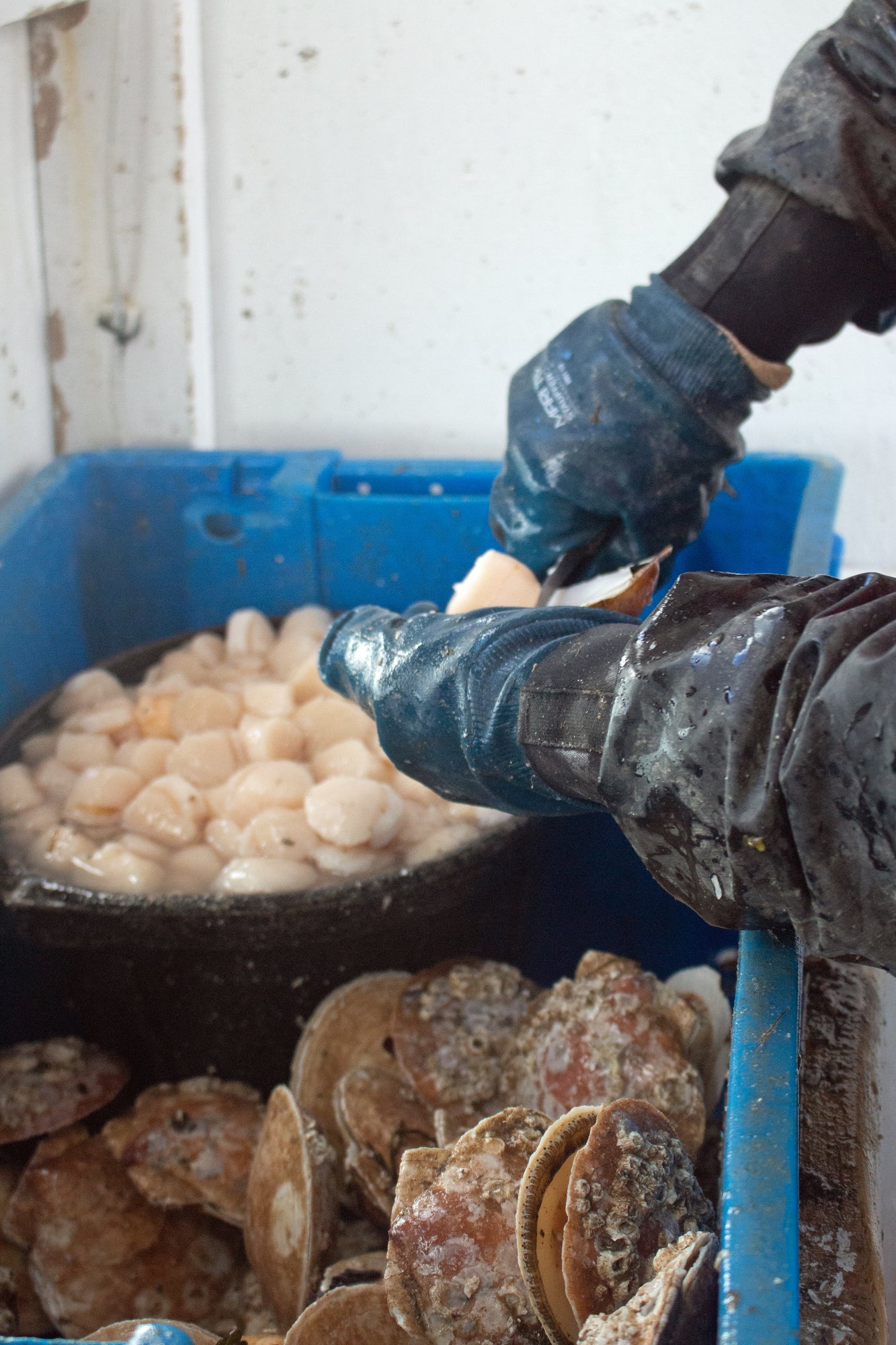
IT'S MAINE'S SCALLOP SEASON!
Photo by Laura Miller
Winter in Maine means lots of things. Cold fingers and toes, no daylight, ice, snow, and a myriad of other hardships Mainers endure year after year. But it also means scallop season, and that’s something to be glad for! Starting in early December our Maine state scallop season opens. Like all of Maine’s small and mostly owner-operated fisheries, it’s full of nuances, generally the season opens earliest in Cobscook Bay, in way downeast Maine. On the heels of the state season which typically closes in March the federal Northern Gulf of Maine season opens, and many of Maine’s scallop fishermen switch over and fish the federal season, which requires going further offshore. Regardless of whether scallops are coming from the in-shore state fishery or the offshore federal fishery, day boat scallops (referred to as “dry” scallops), which are not soaked or held on ice for days, are the best quality scallop you can get. The scallop fishermen we buy from typically Maine lobster during much of the season but in the winter switch over to scalloping to secure a diversified income source and because, well, if you could go scallop fishing, wouldn’t you want to?
We’ve provided a few Q & As to answer all your burning scallop questions below!
What are the Seasons for Scallop Fishing?
For Maine scallop fishermen, there are two scallop seasons, the in-shore, state water fishery which typically runs from early December through sometime in March and the federal Gulf of Maine season which typically runs the month of April.
For the state, inshore fishery, scallops are caught in different zones, close to shore along the coast of Maine. Daily catch limits vary slightly from zone to zone, as do the days on which a scallop fisherman can fish, but typically catch is measured in 5 gallon buckets. For example, in Penobscot Bay, the daily catch limit is three 5 gallon buckets per fishing day (or roughly 130#s), and fishermen can fish on four designated days per week. The Department of Marine Resources, which regulates the inshore fishery, closely monitors the fishery, taking surveys throughout the season. The season is closed on a zone by zone basis based on DMR’s scientific survey results.
The second scallop season is the Gulf of Maine federal scallop season which typically starts around April 1 and runs through the end of April. For Maine day boats, the daily catch limit is 200 pounds of scallop meats per day. This is a quota-based fishery, so when all the boats have caught all the Total Allowable Catch (or TAC), the fishery is shut down.
In addition to the strict catch and seasonality limits, there is also a size limit to scallops; the diameter of the shell must be 4 inches across in order for the scallop to be kept. There are a few other limited seasons, such as for diver scallops, but the majority of Maine’s scallops are landed through these two seasons.
How are Scallops actually caught?
Scallops are caught by towing a drag, which is essentially a metal bag that is towed lightly across the bottom. The “bag” is made up of metal rings that are 4” in diameter. Like the escape valves on lobster traps, the 4” ring lets the babies out, so that when the scallops caught are hauled up on deck,it’s largely a “clean” catch, meaning that most scallops taken out of the water are legal limit. Once scallops are landed on deck, each one that is close to the legal size is measured to be sure it’s legal; any that do not meet the 4” requirement, are thrown back. The rest are shucked one by one by the crew.
How Come Scallops are Never Landed with their Shell on?
Scallops, like all bi-valves, are filter feeders, which means they enhance water quality. During certain times of the year however, part of the scallop, the mantle, can pick up toxins that are harmful to digest, and since there is no way to test all the scallops landed, they are shucked at sea with everything but the meats (the abductor muscle) thrown back into the sea. The meats are the muscle and do not pick up any toxins, they just open and close the shell. Farm raised scallops, a burgeoning industry in Maine, can be landed whole because they go through a rigorous biotoxin testing process before they are landed and sold. They can also be landed at any size, since they are farmed and not wild caught.
What’s a Dry Scallop and why is that Important?
Dry scallops are typically caught on “day boats” caught and landed the same day with strict catch limits. “Trip boats” are out sometimes as long as two weeks, and while they are out, their scallops are stored on ice, which as it melts begins to soak the scallops. These scallops are also typically soaked in phosphates to firm them up. All of which is to say, wet scallops have a diluted flavor profile. Dry scallops are just scallops, caught and landed the same day, providing the best flavor and quality.





